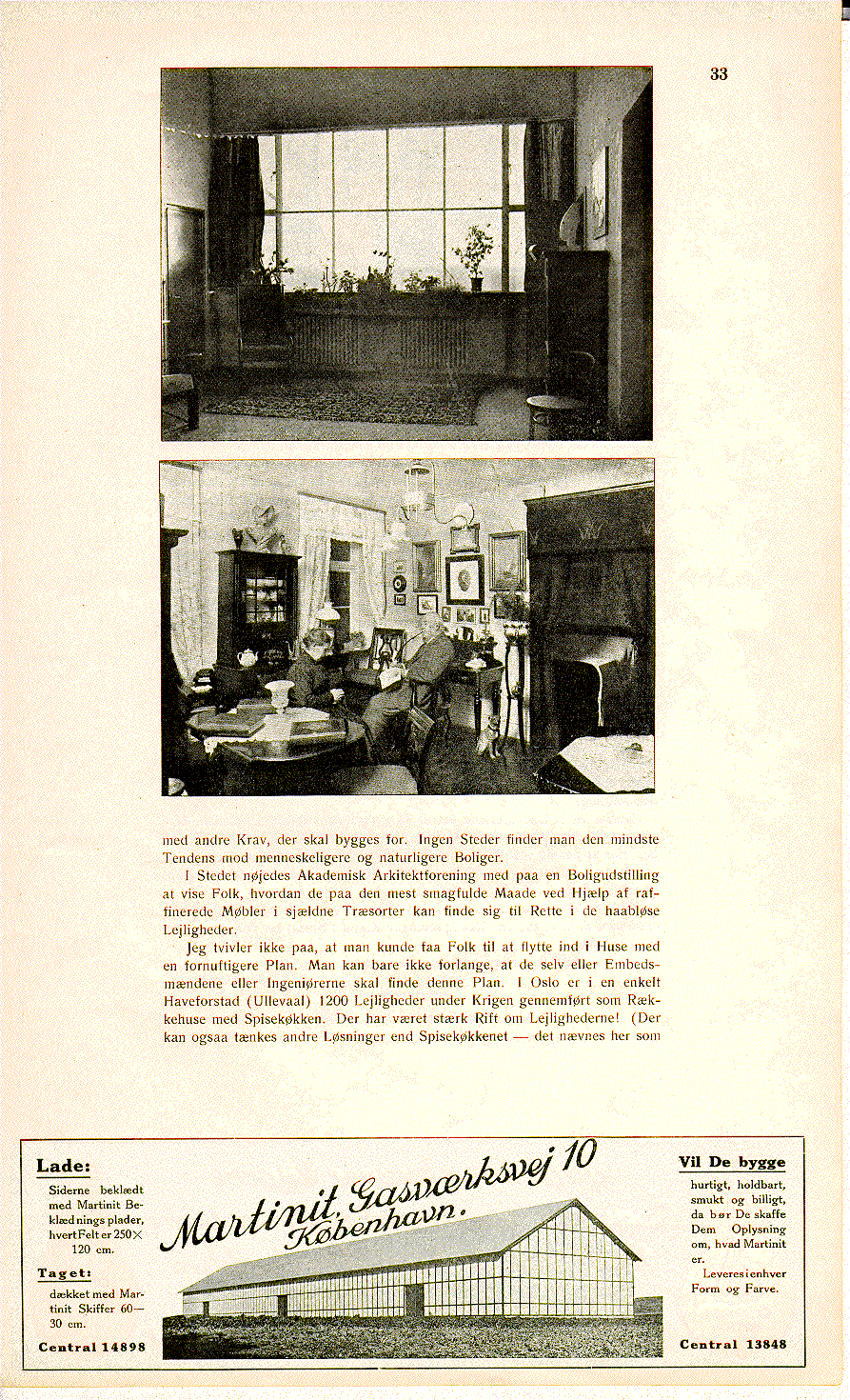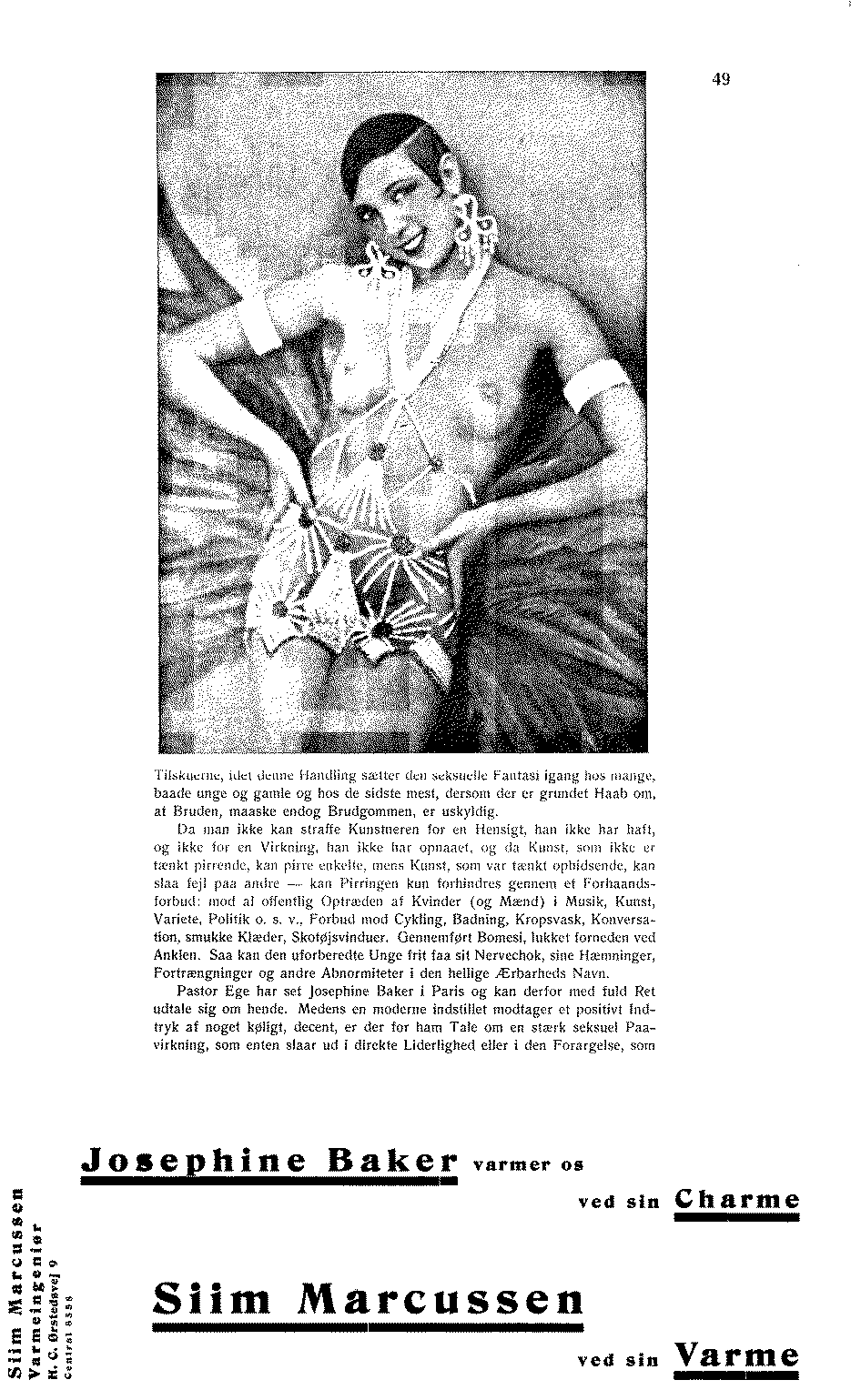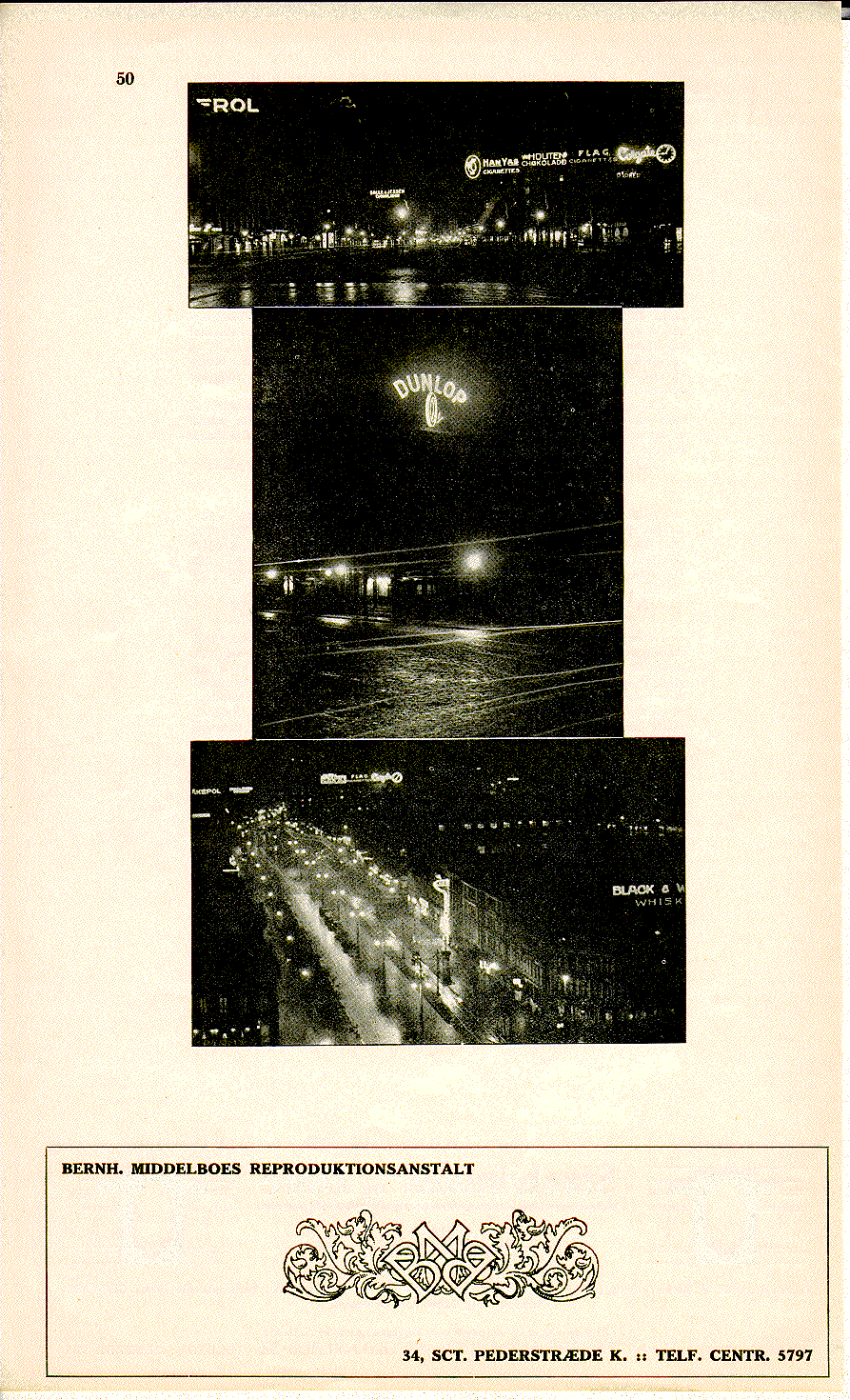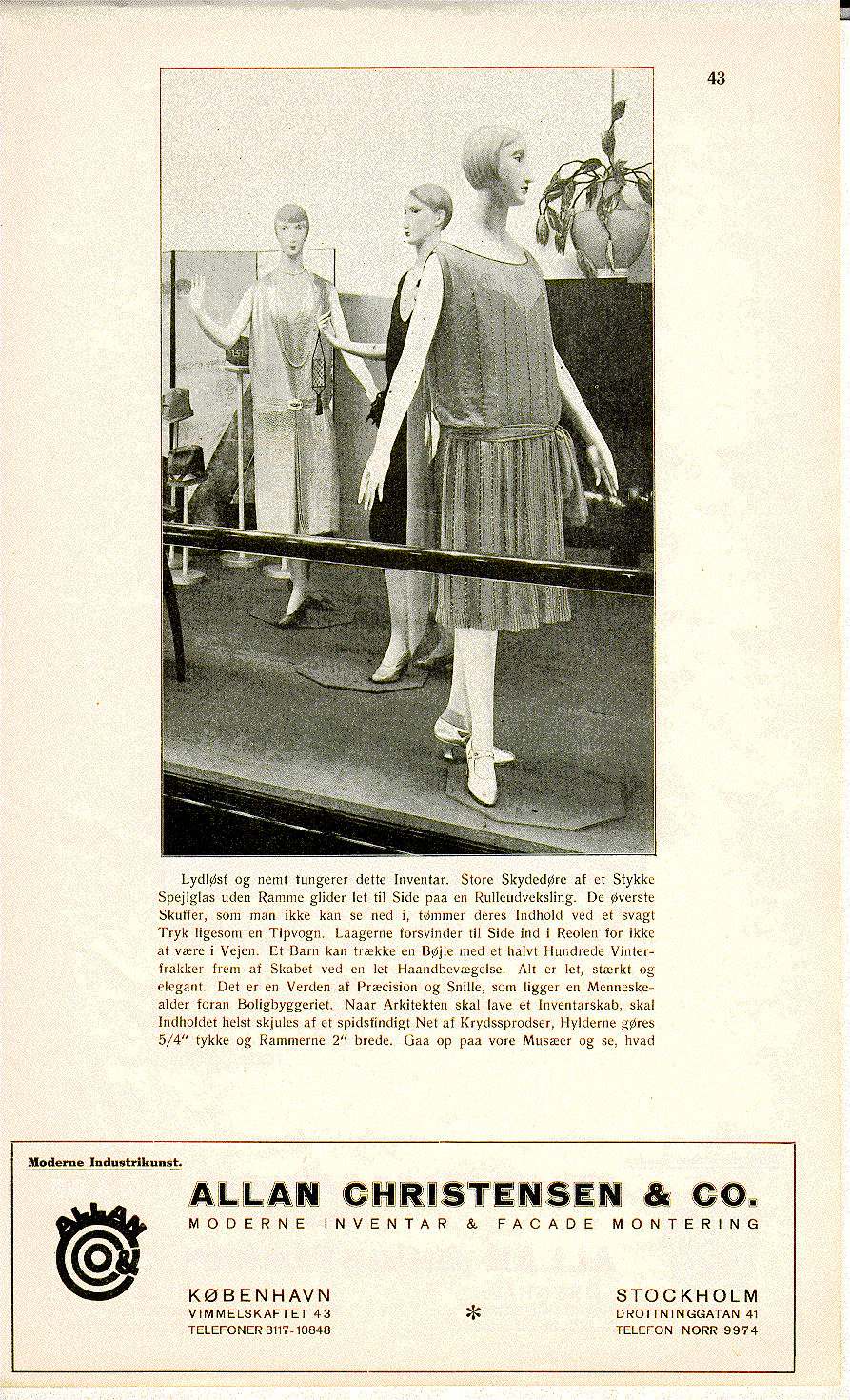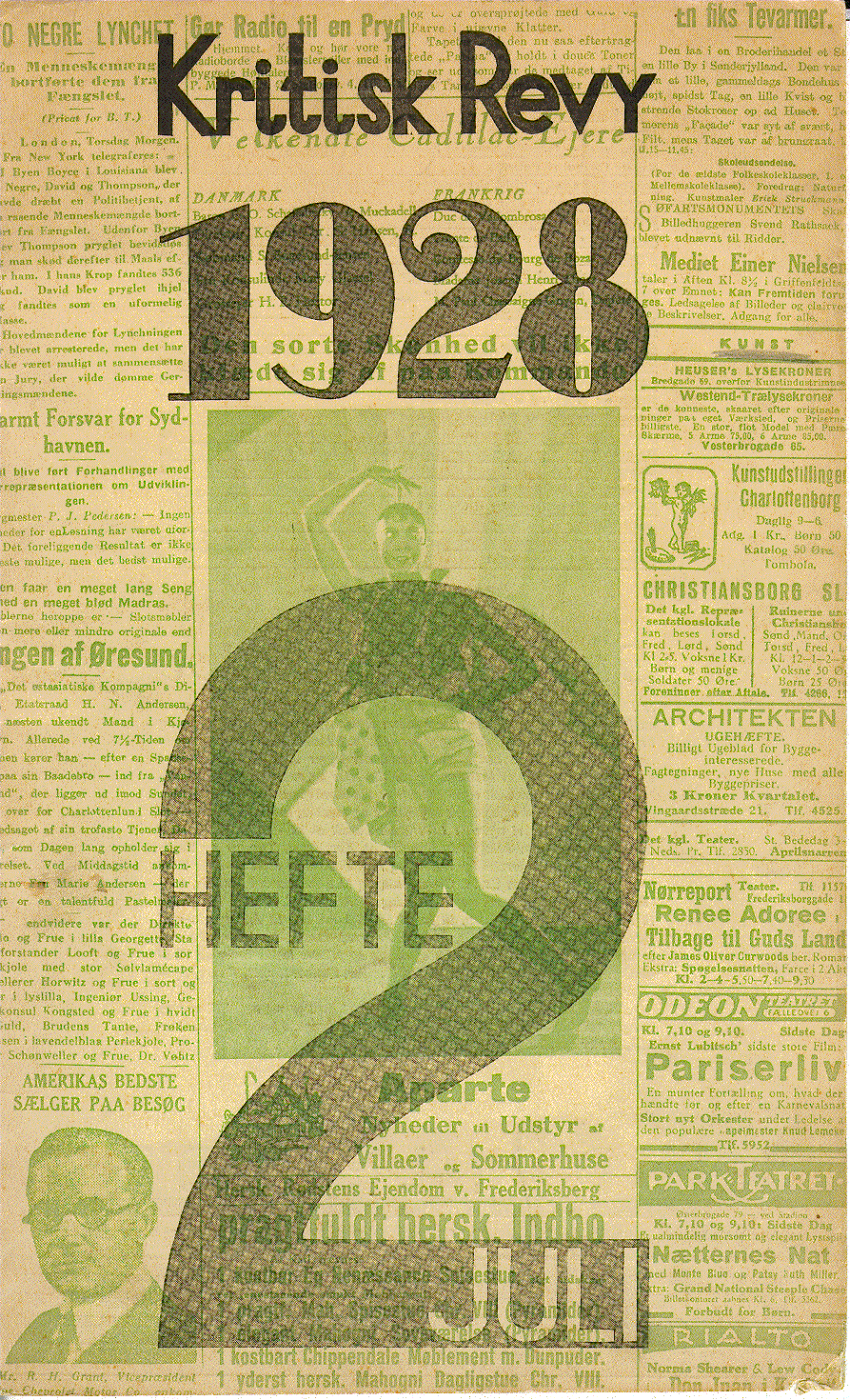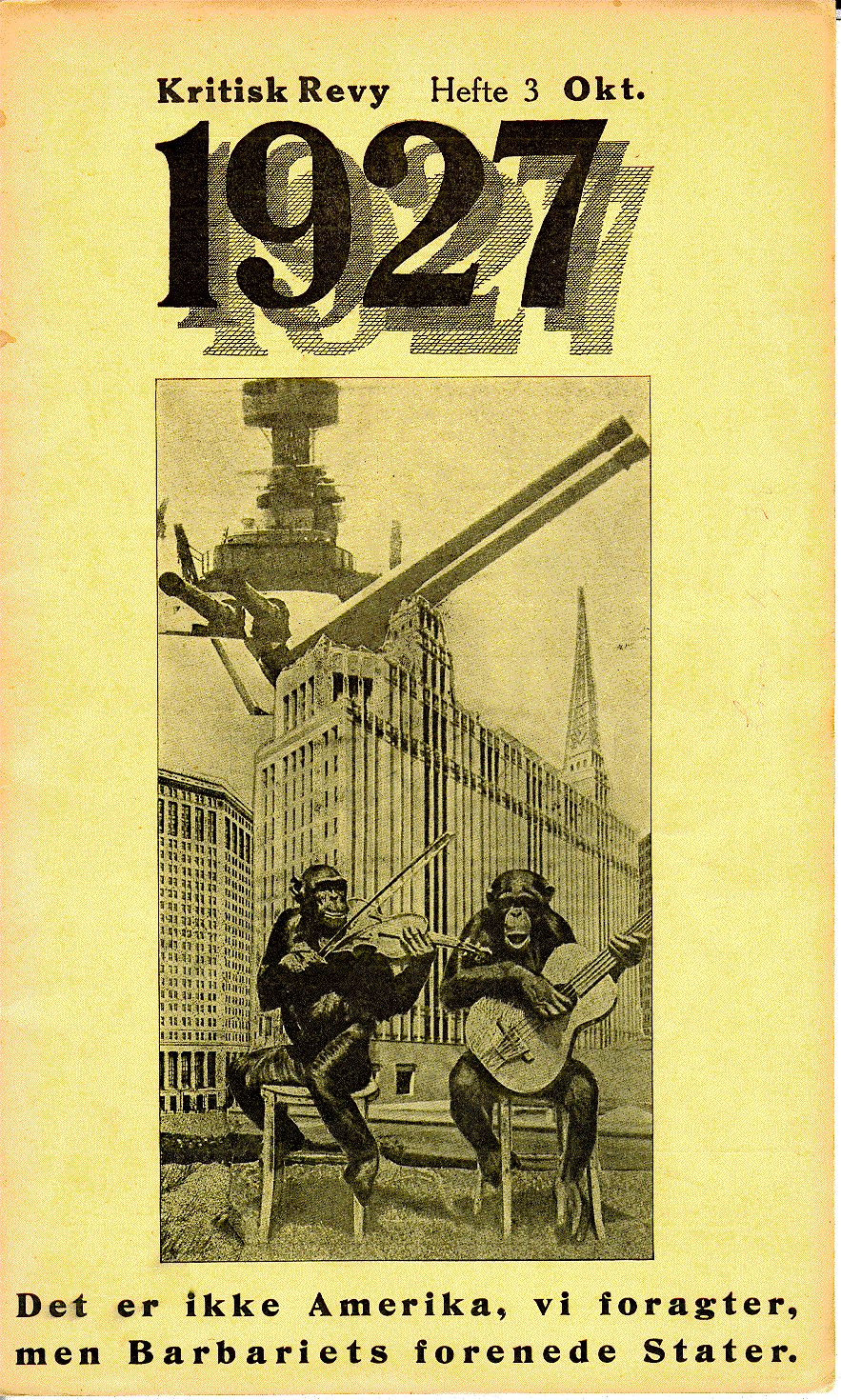|
Torben Jelsbak (Copenhagen) Across the Great Divide. Popular Culture in the Danish Magazine Kritisk Revy (1926–29)
The Danish architectural journal Kritisk Revy (1926–1929) occupies an important position in Scandinavian cultural life and intellectual history of the interwar period. Edited by a group of young left-wing architects and intellectuals, the magazine served as an ideological platform and propaganda vehicle for the functionalist movement in Danish and Nordic architecture and design. Kritisk Revy’s modern concept of architecture and interior design was developed in close contact with contemporary currents in European avant-garde art and architecture, such as Russian constructivism, the German Bauhaus School and the Swiss architect and theorist Le Corbusier. Yet, as part of the magazine's critical strategy of promoting a modern ’democratic’ or ’classless’ culture to replace traditional styles and genres of bourgeois culture, Kritisk Revy also embraced a wide range of phenomena emanating from contemporary popular culture such as the aesthetics of advertising and shop window design, jazz music, and film. This article analyzes how Kritisk Revy’s vision of cultural modernity was developed as a response to these two apparently opposing phenomena of cultural modernity, the artistic avant-gardes and modern capitalist popular culture. The
Danish architectural magazine Kritisk Revy (Critical Review), published in Copenhagen 1926-1929, occupies
an important position in Scandinavian cultural life and intellectual history of
the interwar period. Edited by a group of young left-wing architects and
intellectuals with the designer and critic Poul Henningsen as founder and
driving force, the journal served as a discursive platform and a propaganda
vehicle for the early modernist break-through in Danish and Nordic architecture
and design – or what is today internationally known as Nordic 'functionalism' and Scandinavian Design.
Inspired by contemporary movements in European avant-garde art and
architecture, such as Russian constructivism, the Bauhaus School, and the Swiss modernist architect
and theorist Le Corbusier, Kritisk Revy’s
critical program focused on the promotion of aesthetic solutions within city
planning and interior design that could match the social demands of the modern
industrialized society. The
critical agenda of Kritisk Revy
was, however, not restricted to the field of architecture and design, but
represented a much more comprehensive project of modernization of Danish
culture and society. As a consequence, the magazine covered a wide range of topics
of contemporary modern culture ranging from the aesthetics of advertising and
commodity culture to jazz music, revue songs and film. Thus, nearly all areas
of popular urban culture were embraced as part of the magazine’s critical aim of
developing a modern 'democratic' or 'classless' culture to replace traditional
styles and genres of bourgeois high culture. This
article analyzes how Kritisk Revy’s critical agenda and vision of
modernity developed in dialogue with these two apparently opposing phenomena of
cultural modernity, the artistic avant-gardes on the one hand and capitalist
popular culture on the other. PhiN-Beiheft 6/2013: 29 Avant-Garde and Popular CultureThe
relationship between modernism, avant-garde, and popular culture is a central
and much debated topic in modern art theory and cultural studies. For the
earliest critics and theorists of artistic modernism, such as Clement Greenberg
and Theodor Adorno in the 1930s and 40s, the two phenomena did not have much in
common.1 Greenberg’s and Adorno’s conceptions of early
modernism were based on the assumption that the formal experimentalism of early
20th century avant-garde art (cubism, expressionism, surrealism
etc.) constituted a kind of resistance to, or liberation from, the inane and
inauthentic 'kitsch' products emanating from contemporary capitalist mass
culture. For decades, this view dominated the discussion. Yet, within the last
decades a series of studies have pointed to a revaluation of the complex
interrelationship between the two – in Adorno’s words – "twin halves"
of the culture of industrial modernity. An important contribution in this
direction was Andreas Huyssen’s study After
the Great Divide. Modernism, Mass Culture, Postmodernism (1986), which, by
stressing a series of overlooked connections and affinities between the
revolutionary aesthetic and political claims of the inter-war avant-gardes and
the development of contemporary media technology and popular culture, offered a
new and more dialectical approach to the issue. According
to Huyssen, the artistic and political endeavours of the avant-gardes were not
so much to be seen, as in Adorno and Greenberg, as a counter response to the
uprising commercial mass culture. Rather on the contrary, many of the aesthetic
experiments and innovations of the avant-gardes drew positively on popular
culture in order to distance themselves from traditional bourgeois high art.
One of Huyssen’s key points was that Greenberg and Adorno, by insisting on the
autonomy of modernist art with regard to the social and political contexts of
the surrounding society, ended up by restoring and consolidating exactly that
opposition between high and low, between traditional bourgeois high culture and
modern popular culture, which the avant-gardes sought to destabilize and overcome.
In order to pay heed to this critical endeavour of the avant-garde project, it
was necessary go beyond or work across "the Great Divide" – the
categorical dichotomy between modern art and popular culture. As a consequence,
Huyssen plead for a new paradigm of research that should relocate the study of
the early avant-garde in its social, media and technological contexts of early
20th century society. One
very important media context of the early avant-gardes was the little magazine.
The interwar period saw the emergence of a flourishing culture of small,
independent and inter-artistic magazines, which played a pivotal role in the
formation of the European avant-gardes as a collective, international movement.
The avant-garde magazines served not only as discursive arenas or platforms for
radical artists in their struggle against traditional canons and institutions
within the artistic field. They also became laboratories for artistic creation
and experimentation with materials and genres from outside the field of the
fine arts and traditional bourgeois high culture. In the 1920s this exchange of
materials became especially prominent in new ‘constructivist’ magazines such as
Amédée Ozenfant’s and Le Corbusier’s Esprit
Nouveau (1920–1926) or El Lissitzky’s and Ilja Ehrenburg’s trilingual
Berlin magazine Gegenstand: Vrešc: objet (1922–23),
in which 'high art' genres (art and literature) were mixed with articles on
modern industrial products and advertising as principally equal
"objects" for contemporary artistic creation. In this way, the little
magazine may be regarded as a manifestation of the avant-garde project aiming
at a "fusion" or "sublation of art in the praxis of life",
as described by Peter Bürger in his Theorie der Avantgarde (Bürger 1974: 29). PhiN-Beiheft 6/2013: 30 In
the following, we shall see how this avant-garde or constructivist discourse across the great divide unfolded
in the Copenhagen magazine Kritisk Revy Kritisk Revy. Historical Context and Critical AgendaKritisk Revy was edited by a group of left wing architects
and intellectuals. Besides the responsible editor Poul Henningsen, the most
prominent voices of the magazine were the Norwegian born architect and later
professor at the Bauhaus School
Edvard Heiberg and the two Danish communist authors Otto Gelsted and Hans Kirk.
The editorial staff also included some Swedish members, such as the architects
Otto Linton and Uno Åhren and the national economist Bertil Ohlin, and from
Finland the architect Alva Aalto contributed with theoretical essays on architectural
matters to the magazine. In
its point of departure, Kritisk Revy was
an architectural magazine – or more precisely, as the subtitle of the first
volume suggested, a magazine concerned with "Modern city building, social engineering,
economic technique, and real industrial art". The cover of the first issue
featured an aerial view of the Copenhagen Town Hall Square (Rådhuspladsen), the traffic and popular
center of modern Copenhagen. The cover illustration was a powerful signal of
the primary interest of the magazine which was dedicated to the housing problem
related to the rapid modernization and urbanization of Danish society in the
first decades of the 20th century. The aim was, as the leading
article pointed out, to promote "an architecture in concord with all the
best in the social, economic, and technical efforts of modern culture" (Kritisk Revy, 1926, no. 1, p. 1). What Kritisk Revy wanted to promote was a new
functionalist approach to city planning and housing policy which could meet the
social tasks of modern industrial society – first of all, the creation of good
and healthy housing for the rapidly increasing working class population in the
cities. This
part of the critical agenda was conceived in opposition to what the editors saw
as the ‘false’ New Classicism and ‘snobbish’ conservatism prevailing in
official Danish architecture and housing policy. A preferred point of attack in
the first issues was the newly built Copenhagen Police Headquarters (Politigaarden), whose monumental and
pompous style was a thorn in the eye of the young architects at Kritisk Revy. PhiN-Beiheft 6/2013: 31
Fig. 1: Kritisk Revy, 1927, no. 2, front cover.
The left half of the photomontage is a detail of the Copenhagen Police
Headquarters (Politigaarden), built
1918-1924. In
their view, the style of the building was not only out of touch with the
social, economical and technical efforts of modern society; also on a more
symbolic level it represented an anachronistic, anti-democratic monument – being a
symbol of the political system of absolutism, which was finally abandoned with
the introduction of parliamentary democracy in Denmark in 1901. A crucial
element in Kritisk Revy’s critical
method consisted in this cultural semiotic approach to architecture and
interior design in which any object, from the most monumental architectural
façade to the tiniest piece of furniture, was regarded as a sign encoded with a
more or less subtle layer of meaning. It
was in order to fight against such anachronistic buildings and symbols of power
in the contemporary urban landscape that Kritisk
Revy launched its campaign to support a modern, rational and functional
city planning that could meet the ‘social’ challenges of modern industrialized
society. The overriding challenge for contemporary city planning was how to
provide housing for the rapidly growing working class population in Copenhagen.
Kritisk Revy’s solution to his
problem and a key issue in its agitation was the promotion of modern terrace
houses in functionalist style – an architectural program which resulted in a
continuous debate with the Danish Social Democratic Party on the question what
architectural style that was to be championed by the worker’s party (cf. Dahl
2002). Kritisk Revy argued the case
for the new simple and unpretentious style of functionalism, where as the
social democrats supported New Classicism. In the 19th century, New
Classicism had been the style of the bourgeoisie and those in power, and the
Social Democratic Party wished to emulate it, precisely in order to signal its
own attainment of power. Kritisk Revy,
on its side, argued that the Social Democrats should advocate the use of
functionalism as a component in the development of an independent working class
culture. PhiN-Beiheft 6/2013: 32 Yet,
this discussion was not only about architectural styles and housing policy, but
concerned a much more comprehensive political project of modernization of
contemporary Danish culture. The aim was to develop a modern, 'democratic' and
'classless' style in housing, interior design and everyday life, which could
replace the inherited forms of 19th century bourgeois culture. In
formulating this project, the magazine evoked the Soviet Bolshevik leader and
Marxist revolutionary Leon Trotzky’s proclamations (from Literature and Revolution, 1924) about the making of a future
proletarian culture: "The historical meaning and moral greatness of the
proletarian revolution lies in the fact that it lays the basis for non-class
and the first genuinely human culture" (1927, no. 3, cover). In
this connection, however, the cultural reformers and social engineers at Kritisk Revy were faced with another
problem, consisting in the fact that the upcoming Danish working class, when it
came to housing and interior design, tended to prefer to decorate their homes
with styles and objects inherited from 19th century bourgeois
culture. To the chagrin of the Kritisk
Revy staff, this made the average working class home look like an
overfilled museum or second hand shop for 19th century Victorian
culture, filled with heavy plush covered furniture and decorative objects such
as fan palms, embellished chemises and old porcelain. As a consequence, Kritisk Revy saw it as its mission to
promote and to inspire to the development of a modern and independent working
class culture in housing and interior design as a means to avoid the upcoming
working class turning into a culturally narrow minded petite bourgeoisie.
Fig. 2: Kritisk Revy, 1927, no. 1, p. 33. PhiN-Beiheft 6/2013: 33 With
this ambition of promoting a deliberately modern style in housing and interior
design, Kritisk Revy was closely
related to contemporary currents in European avant-garde architecture and
design such as Russian constructivism, the German Bauhaus School and the influential Swiss architect and theorist of
architectural modernism Le Corbusier – all of which were thoroughly addressed
in the magazine. Yet, it is also characteristic that Henningsen and his fellow
colleagues made great efforts to distance and differentiate themselves from the
aesthetics of international modernism which was continuously criticized for its
aesthetic purism and supposed lack of ‘human’ content and ‘social’ inclination.
Hence, in a long essay dedicated to Le Corbusier’s architectural manifesto Vers une architecture, Poul Henningsen
praised the Swiss architect’s efforts of developing a rational modern
architecture freed from classical ornamentation, while at the same time he
criticized Le Corbusier for adhering to an abstract and 'elitist' scientific
formalism that tended to forget the social tasks of contemporary architecture
and city planning (Cf. Kritisk Revy
1926, no. 1, pp. 50–55). Henningsen’s critique of Le Corbusier’s aesthetics led
to a clarification of Kritisk Revy’s
own ideal of a "democratic art" as an endeavour to develop artistic forms
that should no longer be connected to economic value or social prestige, but
should be present and available for the masses in contemporary everyday life:
"With perfect justice we can assert that only a democratic art is of value
today, and only that kind of art which
appeals to and is understood by the masses is modern in the proper sense of the
word." (op.cit. p. 54). The European Avant-Garde and the American SpiritAn
important point in Kritisk Revy’s
critique of international modernism was developed by Poul Henningsen and
Thorkild Henningsen in the essay "The Americanization of Europe"
(1926, no. 1, pp. 10–15) in which the discussion was directly linked to the
subject of modern mass culture. In this essay the two authors once again
criticized what they saw at the tendency to formalist aestheticism and an
uncritical cult of technology prevailing in contemporary German, French and
Russian avant-garde architecture and design. To support this argument the
article contained a series of illustrations featuring examples from
contemporary avant-garde design, provided with short and concise captions
signaling the author’s evaluations of the featured examples. Among the works
exhibited, El Lisitzky’s Lenin Tribune from 1920/24 was held as an example of
modernist "artistry", while a Bauhaus
interior ("Zimmer der Dame") was blamed for its "insane gorging
in the technical" (op.cit. p. 12). Yet, the essay now took a somewhat
surprising step by judging the apparent formalism of European modernism as a
symptom of an increasing "Americanization" of European Culture. To
emphasize this point of view the authors gave the following diagnosis of modern
American mass culture:
PhiN-Beiheft 6/2013: 34 Henningsen and
Henningsen’s harsh critique of the "Spirit" of modern America
articulated a series of ideas which were frequently encountered in European
political and cultural debates at the time. On the one hand, the essay
contained what sociologists would call a "social critique" of
capitalism as a political and economical system – a kind of critique
traditionally rooted in socialism and the labour movement (cf. Boltanski,
Chiapello 1999 , pp. 83–86). On the other hand the essay expressed a more
culturally motivated Anti-Americanism having its roots in European bourgeois
high culture and its elitist contempt for the supposed "inanity" and
lack of "taste, grace and civility" in American culture (Cf. O’Connor
2004). What is most surprising here is that the authors managed to combine
these two kinds of arguments in their critique of European modernist
avant-garde by stressing the affinity between the formal principles of
architectural standardization in Le Corbusier, Bauhaus and Russian constructivism and the American system of
industrial mass production as developed by Fred W. Taylor and Henry Ford. For
Henningsen and Henningsen, the abstract formalism of European modernism was a
token of the same kind of "dehumanization" as the Taylor system of
scientific management and Henry Ford’s principles for mass production and consumption.
Confronted with this shady alliance, Henningsen and Henningsen warned against a
future "Corbusier Fashion" in Danish architecture and design, while
instead advocating their vision of a modern architecture and interior design
endowed with "human" content and social inclination. Or as the essay
conluded: "We believe in an art of human content, art for society’s
sake" (1926, no. 3, p. 15). Another example of Kritisk Revy’s conscious strategy of differentiation and exclusion vis a vis international modernism
appeared in the third issue of the third volume from October 1928 which
contained an anonymous editorial commentary under the heading "Die neue
Sachlichkeit" (1928, 3, p. 5). Being a part of an ongoing debate between Kritisk Revy and the Bauhaus School, the commentary was
published in both Danish and German. It consisted in a photo of a Bauhaus interior followed by a polemical
caption, which proves very illustrative for the values subscribed to
architecture and design in Kritisk Revy:
This short commentary sums up some
of the most important points in the magazine’s critique of international
modernism while at the same time testifying to the positive cultural values
coming from the magazine’s peculiar Danish or Scandinavian vision of a modern design.
It was in order to avoid the cool, impersonal and machine-like aesthetics of
international modernism that Kritisk Revy
conceived its 'functionalist' aesthetics as a kind of 'soft' modernism
endowed with peculiar architectural design values such as humanity and
‘cosiness’ (in German: Gemütlichkeit
– a word which normally does not appear in the artistic manifestoes of early 20th
century European modernism). It was the same values that
were highlighted in the magazine’s promotion of modern design products. Thus, the modern terrace house in
functionalist style was qualified as a ‘human’ kind of housing providing modern
man with light, fresh air and opportunities for physical activity. Likewise,
Poul Henningsen’s PH-lamp, launched in 1925 and today considered an icon of
early Scandinavian design, was marketed as a method of lighting which, by means of
its "soft" and "warm" light, could bring a feeling of
cosiness and warmth into the modern home. PhiN-Beiheft 6/2013: 35
Fig. 3: Kritisk Revy, 1926, no. 3, back cover. Today, some of the same values are
still championed as important semantic components of the concepts of Danish and
Scandinavian Design. In this way Kritisk Revy’s discourse on modern architecture and
design can be seen as the very beginning of 'Scandinavian Design' in the
modern meaning of the word – with all its peculiar connotations of cultural
freedom and social equality. What is interesting here is that such concepts did
not emerge spontaneously out of the soul of Scandinavian peoples, but were developed
as part of a nationalistic response or act of resistance to the aesthetics of European
modernism. PhiN-Beiheft 6/2013: 36 Commodity Culture and Showroom AestheticsKritisk Revy served not only as bulletin of
architectural and cultural critique but also as commercial advertising pamphlet
for modern design products, architectural firms, and building materials. The
founding of the elegant and richly illustrated magazine was due to Poul
Henningsen's own success as industrial designer. It was the instant commercial
success with the PH-lamp which made it possible to start the magazine, and
Henningsen did not hesitate to use the magazine as advertisement platform for
this and other products by his fellow editors and collaborators. The first
issue of the magazine contained no less than 21 advertisements for the PH-lamp.
The magazine’s advertisement policy was clearly addressed in an editorial
remark in the first issue stating that "All advertisements concerning
modern materials and constructions are selected by the editors" (1926, no.
1, p. 25). The way in which advertisements were used actively as part of both Kritisk Revy’s agitation and layout offers an interesting example of the
magazine's relation to capitalist commodity culture. The
classified advertisement column situated at the bottom of the page was an
integral part of the textual content and editorial agenda. The editors took charge not only of the
selection of products, but also of the verbal form of the advertisements which
were all formulated in the magazine’s distinct style with the use of the
adjectives "modern", "functional", "rational",
"economic" as most recurrent buzzwords. In this way, it became clear
to the reader that the adverts were also part of the magazine’s political
agenda. In some cases, the two components, text and advertisement, even entered
into a kind of discursive interplay with each other. A humoristic example on
this was Henningsen’s enthusiastic essay on the French-American singer and
dancer Josephine Baker in the third volume (1928, no. 1, p. 49) which was
accompanied by an advertisement for the central heating engineering firm Siim Marcussen under the slogan:
"Josephine Baker warms us with her charm. Siim Marcussen with his
warmth." ("Josephine Baker
varmer os ved sin Charme. Siim Marcussen ved sin Varme" – in Danish
the two lines forms a couplet united by the rhyme on "Charm:
Warmth").
Fig. 4 Kritisk Revy, 1928, no. 2, p. 49. A
recurrent topic in recent research on the early 20th century
avant-gardes has been the question to what extent the aesthetic innovations and
practices of the avant-gardes were determined by contemporary consumer culture
– Kritisk Revy offers an interesting
material to the discussion of this problem and its inherent complexities. As
shown in the previous section, Hennnigsen and his fellow colleagues were eager
critics of the "Americanization" of contemporary European culture on
a political level, yet, on the other side, Kritisk
Revy was characterized by a deep fascination with modern capitalist
commodity culture as it was displayed in advertising or in the illuminated shop
windows, neon signs and commercial billboards of the modern city.
Fig. 5: Kritisk Revy, 1927, no. 1, p. 50. PhiN-Beiheft 6/2013: 37 Hence,
the writer and former cubist painter Mogens Lorentzen wrote several
enthusiastic essays about the aesthetic potentialities of modern advertising in
which he argued for a closer collaboration between art and advertising.
"The realm of art is greater than a plate with three apples" (1926,
no. 2, p. 21), he declared with allusion to his own background as a painter,
and he continued: "Advertising is an art; it takes both imagination and
psychological insight to create the right advert, both the visual symbol and
the verbal text, which must be like a proverb" (op.cit., p. 22). On the
basis of this artistic approach to advertising, Lorentzen argued in favor of
the unrestricted freedom and dissemination of advertising in the public space
through the means of posters and major size billboards etc. "The
commercial poster should not only be put up in large size (…) its command
should be spread out to all hoardings." (op.cit., p. 27), he ended his
capitalistic hymn to the new art genre.
Fig. 6: Kritisk Revy, 1927, no. 1, p. 43. Also
the communist architect Edvard Heiberg saw interesting potentials in modern
commodity culture. In an essay on "Shop Fittings" (1927, no. 1, pp.
42–45), he even argued that the solution to the problem of how to design the
classless and functional housing of the future was to be found in the interior
design of modern shops and department stores. For Heiberg, the arrangement of
the modern showroom with transparent plate-glass showcases, closets and modular
shelves constituted the ideal of the 'neutral' piece of furniture which did not represent anything but itself
and its function: to display to commodities for the consumer. Heiberg’s vision
of the private home of the future perfectly expresses the affinity between
modern capitalist commodity fetishism and the functionalist ideals of interior
design:
PhiN-Beiheft 6/2013: 38 In the fascinating picture of capitalist
commodity culture, the communist Heiberg saw the model of the
"democratic" and "classless" interior design that could
furnish the future working class home. It may be disputable if this solution
was in harmony with Kritisk Revy’s
claim for a "social" art of "human" content, but in any
case the examples show how seriously the young architects of the group took
the task of developing a modern aesthetics of design. What is especially
striking here is that the architects at Kritisk
Revy should find this solution in contemporary capitalist shop aesthetics
and not in the innovative interior designs of international modernism which –
be recalling the Bauhaus example
quoted above – were rejected as sterile and inhuman. Jazz Music as Cultural EmancipationAnother
phenomenon of contemporary cultural modernity which received the utmost
attention by the magazine was jazz music. Before entering this subject, it may
be worth noticing that in the cultural discourse of the 1920s the notion
"Jazz" did not have the same meaning as it has today. Jazz music had not yet become a musical genre
in its own right. Instead the word "Jazz" was used as a
non-discriminative umbrella term for any kind of modern dance or entertainment
music. Furthermore, the term also contained chauvinist and racist connotations
as to the Afro-American origin of the phenomena. In the overtly racist
discourse surrounding the subject in contemporary Danish public, Jazz was often
described as a barbarian kind of "negro art" whose popularity was a
sign of the imminent end of occidental culture (cf. Wiedemann 1982, p. 111).
Even critics who took a positive stance to the phenomena were driven by quasi
racist ideas, in which jazz music was linked with ideas of the genuine musicality
and sensibility of "primitive", i.e. black people. Kritisk Revy was not totally free from
such ideas when it praised the emancipating qualities of jazz music with regard
to classical European art music, yet the jazz discourse of the magazine was at
the same time guided by an attempt to approach the phenomena in a more formal
or objective manner. Hence, in an essay on "Jazz Music and Art
Music", the Danish composer Jørgen Bentzon started off by refusing the
racist theories about jazz music’s allegedly black roots, while instead
stressing the influence of European musical traditions on the emergence on the
genre. In the following essay Bentzon tried to develop a formal approach to
jazz music by describing its aesthetic attraction as consisting in its
"free" and "syncopated" rhythms in which he saw a parallel
to Kritisk Revy’s functionalist and
utilitarian aesthetic:
PhiN-Beiheft 6/2013: 39 Bentzon’s
attempt to translate the musical language of jazz into Kritisk Revy’s critical and cultural discourse ("the task", "the rhythmical
movement" etc.), as manifestations of a modern kind of applied art freed
from pushing outburst of feeling, forms an interesting parallel to Heiberg’s
salutatory description of the modern show room’s gracious universe of comfort
and perfection quoted in the previous section. On the basis of this
interpretation of the aesthetic attraction of jazz music Bentzon saw no reason
to fear the influence of jazz on modern European art music. On the contrary, he
foresaw interesting aesthetic potentialities in a mutual interaction between
the two genres. As a powerful example of the appropriation of jazz features in
contemporary art music he stated Kurt Weill and Bertold Brecht’s song play Mahagonny (performed for the first time in
Baden-Baden 1927) which he saw as the most genius work in contemporary German
music.
Fig. 7: Kritisk Revy, 1928, no. 2, front cover. Another
interesting example of Kritisk Revy’s
cultural reception of jazz music was
Poul Henningsens enthusiastic embrace of the African American-born, French
dancer and singer Josephine Baker. In the summer of 1928, Baker made a series
of shows in a popular Copenhagen theater, performing her peculiar "Dance
sauvage" dressed in a primitive banana skirt. Baker’s performance
consciously evoked both sexual fantasies and racist stereotypes that were
common in the period and the show was disdained as "dirty Negro
dance" and "pornography" by conservative critics. Henningsen on
his side took another stance defending enthusiastically the artistic value of
Baker’s performance in an essay entitled "The Educational Value of
Pornography" (1928, no. 2, pp. 48–53). Henningsen’s defence of Josephine
Baker against the moral condemnation of conservative critics consisted in
saying that her naked dance performance was not to be regarded as pornography
but as an art form. When older critics were so offended by Baker, he argued,
this was due to the fact that they could only perceive nakedness as sexual excitation,
whereas the younger generation were able to look more soberly at things and
appreciate Baker’s dance as an object for "disinterested pleasure"
(op.cit., p. 50), as Henningsen put it with allusions to a key concept in 19th
century art theory. For Henningsen this difference between his and older
generation’s way of perceiving Baker constituted no less than a step forward in
the development of western civilization since it pointed towards a refinement
of taste in a more pure, more aesthetic or sensorial direction. In such a way
Henningsen conceived Josephine Baker as an icon of cultural emancipation in
perfect congruence with Kritisk Revy's
critical agenda: PhiN-Beiheft 6/2013: 40
The United States of BarbaryHenningsen’s
enthusiastic defense of Baker sums up some of the most important elements and
paradoxes inherent to Kritisk Revy’s
view on modern popular culture. The magazine’s embrace of popular phenomena,
advertising, jazz music, variety shows and other kinds of popular
entertainment, could be seen as a logic continuation of the magazine’s
political mission of developing a modern democratic and classless culture,
freed from the burdens of traditional bourgeois high culture. However, when
arguing for the artistic value of such phenomena, the magazine often drew on
concepts borrowed from traditional bourgeois high culture and aesthetics, such
as in the case with the allusion to the Kantian concept of "disinterested
pleasure" quoted above. In the same way, Kritisk Revy's view on modern American popular culture was
characterized by a fundamental schism between a liberal and utilitarian
enthusiasm for the democratic and emancipating potentials of capitalist culture
and a classical highbrow disdain for the inane cult of technique and material
wealth which was associated with modern capitalist America. This conflict
received an iconic expression in Henningen’s photo-montage on the cover of the
third issue of the second volume from October 1927, featuring two music making
monkeys in front of New York skyscrapers armed with gun barrels.
Fig. 8: Kritisk Revy, 1927, no. 3, front cover. PhiN-Beiheft 6/2013: 41 The
message would seem clear, yet the montage was coupled with the explaining
caption: "It is not America we despite but the United States of
Barbary." Bearing
a resemblance to the didactic rhetoric of John Heartfield's contemporary
photo-montages, Henningsen's use of the proto avant-garde genre of montage was
the more striking in that it expressed a view on Modernity and American culture
which was in fact in conformity with the most conservative and chauvinistic
voices in the cultural debate of interwar Europe. In a Danish context
Henningsen's legendary photomontage has tricked generations of interpreters. How
could the otherwise progressive and liberal Poul Henningsen, whom, after the
Second World War, was to receive a status as icon for the progressive,
anti-totalitarian left-wing in Denmark, come up with something as politically
incorrect as this photomontage which was difficult not to read as a racist
attack on America and modern Afro-American popular music? – Yet, as we have
seen in the previous examples the photomontage was in no way unique or
non-representative for the cultural discourse in Kritisk Revy. On the
contrary, the montage constitutes a striking proof of the fundamental
ambivalence characterizing Kritisk Revy's
view not only on modern (American) popular culture but on cultural modernity as
a whole. BibliographyBibliographical
Note: A digital facsimile edition of Kritisk
Revy is available as online resource from the Danish Royal Library in
Copenhagen through the library's web catalogue "REX". This edition
however contains only 7 out of the 10 originally published issues of the
magazine. Adorno, Theodor W./ Horkheimer, Max (1947):
Dialektik der Aufklärung, Amsterdam: Querido. Ashby,
LeRoy (2010): "The Rising of Popular Culture: A Historiographical Sketch",
in: OAH Magazine of History, 24 (April 2010), 11–14. Boltanski,
Luc/ Chiapello, Éve (1999): Le nouvel
esprit du capitalisme, Paris: Gallimard. Bürger, Peter (1974): Theorie der Avantgarde, Frankfurt am Main: Suhrkamp. Dahl, Jan (2002): "Kritisk Revy over arbejdernes
boliger", in: Arbejderhistorie,
no. 4, 2002, 18–35. Greenberg,
Clement (1939): "Avant-Garde and Kitsch", in: Partisan Review, 1939, no. 5, 34-49. Huyssen,
Andreas (1986): After the Great Divide:
Modernism, Mass Culture, Postmodernism, Blomington: Indiana University
Press. O'Connor,
Brendan (2004): "A Brief History of Anti-Americanism from Cultural Criticism to
Terrorism", in: Australasian Journal
of American Studies, July 2004, 77–92. Suárez,
Juan Antonio (2007): Pop modernism. Noise and the Reinvention of the Everyday, Illinois: University of Illinois Press. Wiedemann, Erik (1982): Jazz i Danmark i tyverne, trediverne og fyrrerne. En musikkulturel
undersøgelse, vol. 1, Copenhagen: Gyldendal. Notes1 The most influential contributions to this discussion and the categorical dichotomy between avant-garde and popular culture are Clement Greenberg’s essay "Avant-Garde and Kitsch", published in Partisan Review, 1939, no. 5, pp. 34-49, and Theodor W. Adorno and Max Horkheimer’s Dialektik der Aufklärung, Amsterdam, 1947 – the chapter "Kulturindustrie. Aufklärung als Massenbetrug". |

